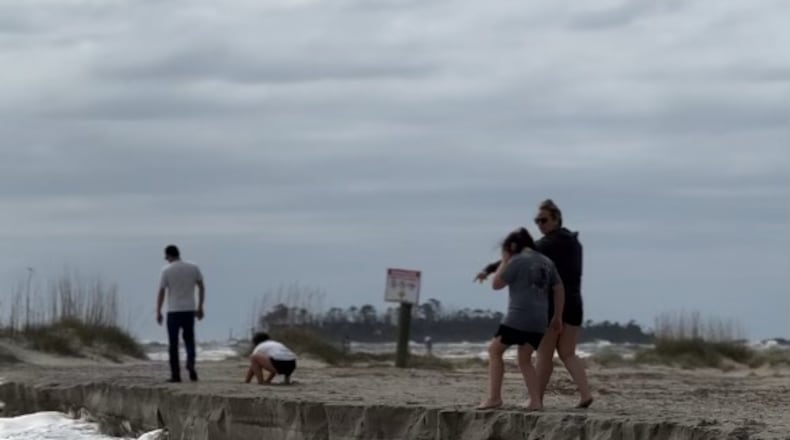TYBEE ISLAND — As a younger man, Bret Bell lived two blocks from Tybee Island’s beach and grew to know the nuances of its gently curving shoreline through his almost daily walks.
He lost that familiarity, though, when he moved to Savannah two decades ago. He started a family and spent little time at the beach. Only in recent months, when he applied for and was ultimately hired as Tybee’s city manager, did he become a beach regular again.
What he’s observed about the beach’s topography concerns him.
This summer has brought rapid shoreline erosion as heavy surf driven by East Coast weather systems and three named storms, including Hurricane Milton this week, have pounded Tybee’s sands. The island’s shore is replenished every seven years with sand pumped from the ocean floor. However, Milton’s 11-foot-high waves created cliffs in some spots and reclaimed parts of newly constructed protective sand dunes in others.
The next renourishment isn’t scheduled until late 2026.
Credit: Adam Van Brimmer
Credit: Adam Van Brimmer
As Bell, Tybee Mayor Brian West and other officials assessed the latest damage, they had the same question: Is the beach going to make it through two more hurricane seasons, given that every storm can wash away as much as a year’s worth of sand?
“We’re five years into this cycle, and erosion is a year ahead of schedule,” said Alan Robertson, a retired banker turned coastal resiliency expert. “We’re going to really need that sand.”
Tybee is well into the planning for the 2026 renourishment. West announced during Thursday’s city council meeting a $4 million commitment from the state of Georgia toward the $20 million project. The federal government will cover $12 million in costs, and the city of Tybee Island and Chatham County are expected to fund the balance.
The next renourishment could be unlike any Tybee has experienced since the first beach replenishment was done in 1975. Erosion has exposed long-buried elements of beach infrastructure in some areas, such as the foundations of the rock jetties that bookend the 3-mile-long shorefront.
In 2016, the surf washed away enough sand to bare pieces of corrugated metal roofing that were laid along some areas of the beach to stabilize it before past renourishments. Those metal sheets were removed due to safety concerns, and the loose sand beneath it became dunes that have eroded at a rapid pace.
Robertson, who has been consulting with the Tybee government on resiliency projects since 2018, has been tracking the erosion in collaboration with the University of Georgia’s Skidaway Institute of Oceanography, which uses camera-mounted drones to survey the shore. They’ve paid particular attention to the easternmost point of the beach, as well as three human-made sand dunes built in 2019 just ahead of the last renourishment.
Credit: Adam Van Brimmer
Credit: Adam Van Brimmer
The dunes’ cores are a series of sandbags made from polypropylene, a durable type of plastic packaging. Builders piled loose sand on top and planted vegetative grasses and picket fencing that trap sand near the dune’s surface.
The dunes are an experiment in beach protection. Constructed strategically in spots where a series of storms, including 2017′s Hurricane Irma, pushed floodwaters into the island’s streets, the dunes have performed as designed.
Known as the Dune Restoration Project, the natural barriers are considered a model for others to follow. In fact, state lawmakers on House and Senate study committees were to tour the dunes Thursday, a visit that was postponed due to Hurricane Milton.
The 2026 renourishment will include sand to stabilize the dunes and likely expand them to protect the seawall and other infrastructure. Robertson pointed to what 2005′s Hurricane Katrina did to levees and other protective stormwater barriers in New Orleans as reason for seeking alternative solutions.
“When walls fail, they fail catastrophically,” Robertson said. “With nature, if it fails, it fails gracefully. You add more sand. You expand your dunes. It gives you time.”
The dunes will buy Tybee vital time until the next renourishment. Robertson said it is unlikely the U.S. Army Corps of Engineers will start the 2026 project early. However, the erosion supports the argument that the federal government should shorten Tybee’s seven-year renourishment cycle.
“The beach is our economy,” Mayor West said. “If we had rocks, we would not have visitors, and our island would be very different.”
About the Author
Keep Reading
The Latest
Featured





